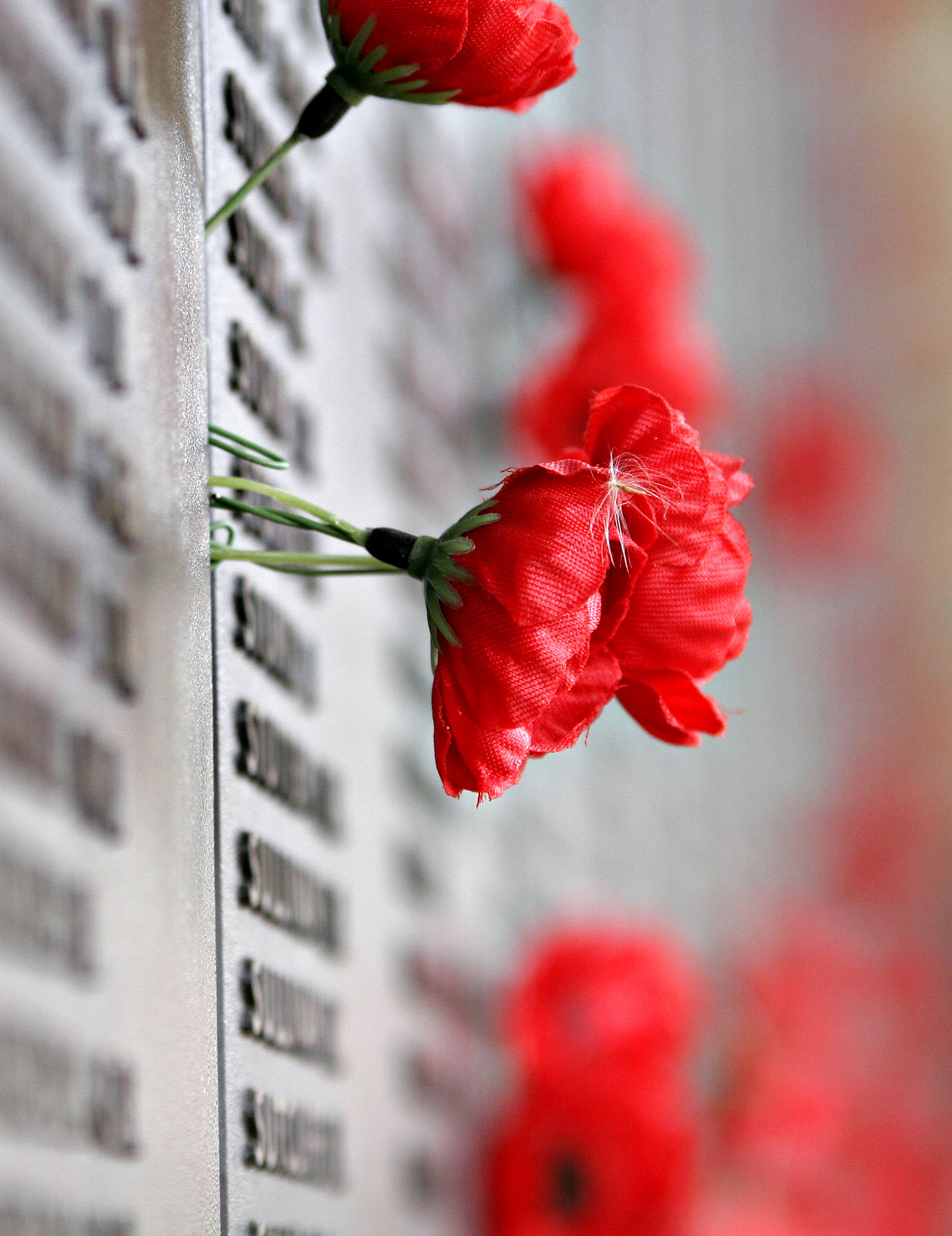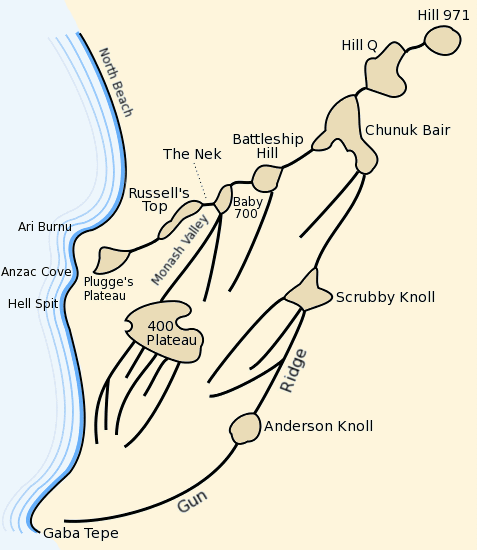|
ANZAC
The Australian and New Zealand Army Corps (ANZAC) was a First World War army corps of the Mediterranean Expeditionary Force. It was formed in Egypt in December 1914, and operated during the Gallipoli campaign. General William Birdwood commanded the corps, which primarily consisted of troops from the First Australian Imperial Force and 1st New Zealand Expeditionary Force, although there were also British and Indian units attached at times throughout the campaign. The corps disbanded in 1916, following the Allied evacuation of the Gallipoli peninsula and the formation of I ANZAC Corps and II ANZAC Corps. The corps was reestablished, briefly, in the Second World War during the Battle of Greece in 1941. History Original formation Plans for the formation began in November 1914 while the first contingent of Australian and New Zealand troops were still in convoy bound for, as they thought, Europe. However, following the experiences of the Canadian Expeditionary Force encamped ... [...More Info...] [...Related Items...] OR: [Wikipedia] [Google] [Baidu] |
Anzac Day
, image = Dawn service gnangarra 03.jpg , caption = Anzac Day Dawn Service at Kings Park, Western Australia, 25 April 2009, 94th anniversary. , observedby = Australia Christmas Island Cocos (Keeling) Islands Cook Islands New Zealand Niue Norfolk Island Tokelau Tonga , duration = 1 day , frequency = Annual , scheduling = same day each year , date = 25 April , observances = Dawn services, commemorative marches, remembrance services , type = historical , longtype = Commemorative, patriotic, historic , significance = National day of remembrance and first landing of the Anzacs at Gallipoli , relatedto = Remembrance Day Anzac Day () is a national day of remembrance in Australia and New Zealand that broadly commemorates all Australians and New Zealanders "who served and died in all wars, conflicts, and peacekeeping operations" and "the contribution and suffering of all those who have served". Observed on 25 A ... [...More Info...] [...Related Items...] OR: [Wikipedia] [Google] [Baidu] |
I ANZAC Corps
The I ANZAC Corps (First Anzac Corps) was a combined Australian and New Zealand army corps that served during World War I. It was formed in Egypt in February 1916 as part of the reorganisation and expansion of the Australian Imperial Force and the New Zealand Expeditionary Force (NZEF) following the evacuation of Gallipoli in December 1915. Along with the II ANZAC Corps, it replaced the original Australian and New Zealand Army Corps (ANZAC). The corps initially participated in the defence of the Suez Canal before being transferred to the Western Front in France and Belgium in late March 1916. Later in 1916 the New Zealand Division was removed from I ANZAC's order of battle, swapping with II ANZAC's Australian 4th Division. In November 1917, I ANZAC ceased to exist when the Australian infantry divisions in France were grouped together as the Australian Corps and the New Zealand Division, then part of II ANZAC Corps, was allocated to a British corps. History Formation Follow ... [...More Info...] [...Related Items...] OR: [Wikipedia] [Google] [Baidu] |
First Australian Imperial Force
The First Australian Imperial Force (1st AIF) was the main expeditionary force of the Australian Army during the First World War. It was formed as the Australian Imperial Force (AIF) following Britain's declaration of war on Germany on 15 August 1914, with an initial strength of one infantry division and one light horse brigade. The infantry division subsequently fought at Gallipoli between April and December 1915, with a newly raised second division, as well as three light horse brigades, reinforcing the committed units. After being evacuated to Egypt, the AIF was expanded to five infantry divisions, which were committed to the fighting in France and Belgium along the Western Front in March 1916. A sixth infantry division was partially raised in 1917 in the United Kingdom, but was broken up and used as reinforcements following heavy casualties on the Western Front. Meanwhile, two mounted divisions remained in the Middle East to fight against Turkish forces in the Sinai an ... [...More Info...] [...Related Items...] OR: [Wikipedia] [Google] [Baidu] |
William Birdwood
Field Marshal William Riddell Birdwood, 1st Baron Birdwood, (13 September 1865 – 17 May 1951) was a British Army officer. He saw active service in the Second Boer War on the staff of Lord Kitchener. He saw action again in the First World War as Commander of the Australian and New Zealand Army Corps during the Gallipoli Campaign in 1915, leading the landings on the peninsula and then the evacuation later in the year, before becoming commander-in-chief of the Fifth Army on the Western Front during the closing stages of the war. He went on to be general officer commanding the Northern Army in India in 1920 and Commander-in-Chief, India, in 1925. Early life William Riddell Birdwood was born on 13 September 1865 in Kirkee, India. His father, Herbert Mills Birdwood, born in Bombay and educated in the UK, had returned to India in 1859 after passing the Indian Civil Service examination. In 1861, Herbert Birdwood married Edith Marion Sidonie, the eldest daughter of Surgeon-Major ... [...More Info...] [...Related Items...] OR: [Wikipedia] [Google] [Baidu] |
II ANZAC Corps
The II ANZAC Corps (Second Anzac Corps) was an Australian and New Zealand First World War army corps. Formed in early 1916 in Egypt in the wake of the failed Gallipoli campaign, it initially consisted of two Australian divisions, and was sent to the Western Front in mid-1916. It then took part in the fighting in France and Belgium throughout 1916 and 1917, during which time it consisted of New Zealand, Australian and British divisions. In November 1917, the corps was subsumed in to the Australian Corps, which concentrated all five Australian infantry divisions. After this, the corps was reformed as the British XXII Corps. History The corps was formed in Egypt in February 1916 as part of the reorganization of the Australian Imperial Force following the evacuation of Gallipoli in December 1915, under the command of William Birdwood. This corps, along with the I ANZAC Corps, replaced the original Australian and New Zealand Army Corps (ANZAC), following the expansion of the Austr ... [...More Info...] [...Related Items...] OR: [Wikipedia] [Google] [Baidu] |
New Zealand Mounted Rifles Brigade
The New Zealand Mounted Rifles Brigade was a brigade of the New Zealand Army during the First World War. Raised in 1914 as part of the New Zealand Expeditionary Force, it was one of the first New Zealand units to sail for service overseas. The brigade was formed from three regiments – the Auckland Mounted Rifles, the Canterbury Mounted Rifles, the Wellington Mounted Rifles – and smaller support units. Altogether the brigade had an establishment of 1,940 men and 2,032 horses and by the end of the war over 17,700 men had served in the brigade. However, the entire brigade's dismounted rifle strength was the equivalent of only a battalion of infantry. By the end of 1914, the brigade had arrived in Egypt and was assigned to the New Zealand and Australian Division. Its first active service was, in a dismounted role, during the Gallipoli Campaign, where they fought against the forces of the Ottoman Turkish Empire. Seven months later, after the evacuation from Gallipoli, the b ... [...More Info...] [...Related Items...] OR: [Wikipedia] [Google] [Baidu] |
New Zealand Infantry Brigade
The New Zealand and Australian Division was a composite army division raised for service in the First World War under the command of Major General Alexander Godley. Consisting of several mounted and standard infantry brigades from both New Zealand and Australia, it served in the Gallipoli Campaign between April and December 1915. At Gallipoli, the division landed at Anzac Cove on 25 April 1915, coming ashore as follow-on troops to the initial assault force that had made it ashore earlier in the day, and later occupied the northern areas of the Allied lodgement. After the initial Allied assault at Anzac Cove, elements of the division were sent to Cape Helles in early May, where they participated in the Second Battle of Krithia, launching an unsuccessful attack towards the Achi Baba peak. The division's mounted units were sent to Gallipoli in mid-May without their horses, to serve as dismounted infantry, making up for previous losses. Later that month, the division helped repe ... [...More Info...] [...Related Items...] OR: [Wikipedia] [Google] [Baidu] |
1st New Zealand Expeditionary Force
The New Zealand Expeditionary Force (NZEF) was the title of the military forces sent from New Zealand to fight alongside other British Empire and Dominion troops during World War I (1914–1918) and World War II (1939–1945). Ultimately, the NZEF of World War I became known as the ''First New Zealand Expeditionary Force''. The NZEF of World War II was known as the ''Second New Zealand Expeditionary Force'' (2NZEF). The 2NZEF was led by General Bernard Freyberg. 1st New Zealand Expeditionary Force The New Zealand Expeditionary Force (NZEF) was the title of the military forces sent from New Zealand to fight for Britain during World War I. Upon the outbreak of war, New Zealand immediately offered to provide two brigades—one of infantry and one of mounted troops—with a total of 8,500 men. As was the case with the Australian army the existing New Zealand army was a "territorial" force, designed for the defense of the home islands. It could not be deployed overseas. Hence, i ... [...More Info...] [...Related Items...] OR: [Wikipedia] [Google] [Baidu] |
New Zealand And Australian Division
The New Zealand and Australian Division was a composite army division raised for service in the First World War under the command of Major General Alexander Godley. Consisting of several mounted and standard infantry brigades from both New Zealand and Australia, it served in the Gallipoli Campaign between April and December 1915. At Gallipoli, the division landed at Anzac Cove on 25 April 1915, coming ashore as follow-on troops to the initial assault force that had made it ashore earlier in the day, and later occupied the northern areas of the Allied lodgement. After the initial Allied assault at Anzac Cove, elements of the division were sent to Cape Helles in early May, where they participated in the Second Battle of Krithia, launching an unsuccessful attack towards the Achi Baba peak. The division's mounted units were sent to Gallipoli in mid-May without their horses, to serve as dismounted infantry, making up for previous losses. Later that month, the division helped rep ... [...More Info...] [...Related Items...] OR: [Wikipedia] [Google] [Baidu] |
First World War
World War I (28 July 1914 11 November 1918), often abbreviated as WWI, was List of wars and anthropogenic disasters by death toll, one of the deadliest global conflicts in history. Belligerents included much of Europe, the Russian Empire, the United States, and the Ottoman Empire, with fighting occurring throughout Europe, the Middle East, Africa, the Pacific Ocean, Pacific, and parts of Asia. An estimated 9 million soldiers were killed in combat, plus another 23 million wounded, while 5 million civilians died as a result of military action, hunger, and disease. Millions more died in Genocides in history (World War I through World War II), genocides within the Ottoman Empire and in the Spanish flu, 1918 influenza pandemic, which was exacerbated by the movement of combatants during the war. Prior to 1914, the European great powers were divided between the Triple Entente (comprising French Third Republic, France, Russia, and British Empire, Britain) and the Triple A ... [...More Info...] [...Related Items...] OR: [Wikipedia] [Google] [Baidu] |
1st Division (Australia)
The 1st Division is headquartered in Enoggera, a suburb of Brisbane. The division was first formed in 1914 for service during World War I as a part of the Australian Imperial Force (AIF). It was initially part of the Australian and New Zealand Army Corps (ANZAC) and served with that formation during the Gallipoli campaign, before later serving on the Western Front. After the war, the division became a part-time unit based in New South Wales, and during World War II it undertook defensive duties in Australia before being disbanded in 1945. After World War II, the division remained off the Australian Army's order of battle until the 1960s, when it was reformed in New South Wales. In 1965 it adopted a certification role, determining the operational readiness of units deploying to Vietnam. It was re-formed in 1973 as a full division based in Queensland and in the decades that followed it formed the Australian Army's main formation, including both Regular and Reserve personnel. Thr ... [...More Info...] [...Related Items...] OR: [Wikipedia] [Google] [Baidu] |
Ceylon Planters Rifle Corps
The Ceylon Planters Rifle Corps was a regiment of the Ceylon Defence Force, which existed between 1900 and 1949. It was a volunteer (reserve) regiment based in Kandy, made up of only Europeans that were tea and rubber planters of the hills of Sri Lanka. The regiment deployed personnel to fight in the Second Boer War, the First, and Second World Wars. History After the disbandment of the Ceylon Rifle Regiment (CRR) in 1873, some British planters and mercantile elite tried to form a volunteer infantry unit loosely known as the Matale Rifle Volunteer Corps but it was disbanded only months after its creation. In 1900, a new regiment named the Ceylon Planters Rifle Corps was established with its headquarters at Kandy; the officers and other ranks were made up of Europeans, who were tea and rubber planters in the central highlands of Ceylon. Its first commanding officer was Colonel R.N. Farquharson, a retired naval captain. The regiment was a volunteer regiment mobilized to respond ... [...More Info...] [...Related Items...] OR: [Wikipedia] [Google] [Baidu] |
.jpg)

.jpg)






